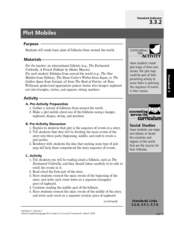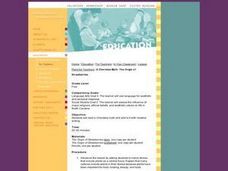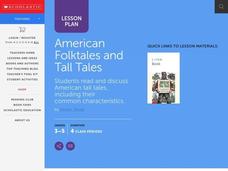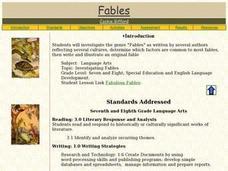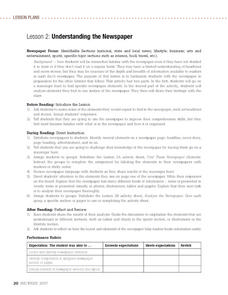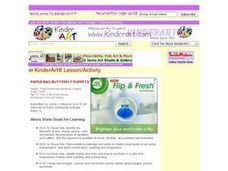Curated OER
Introducing Setting and Accents
Fourth graders discuss the concept of setting and how it affects the events and tone of a story. They observe the cover of the book they are reading and make predictions about the setting. They read the first chapter and then refine...
Curated OER
A Novel Ending/ Closure Activity
Students summarize a story, identify the plot structure, and create a symbol that represents the essence of the story.
Curated OER
Plot Mobiles
Students read folktales and identify the plot of the story by making a mobile. For this inventive and colorful lesson, students listen to a variety of famous folktales, and practice identifying the plot. Then, they work together to...
Curated OER
Laurence Yep's, Dragonwings
Students discuss vocabulary words and compare definitions. They read chapters 6-9 of the novel, Dragonwings, and discuss point of view, and complete a plot diagram. Then they review the four types of conflict and identify the conflicts...
Curated OER
Adventure Writing: Oregon's Landscape as a Setting
Students identify geographical features of different regions encountered by migrants on the Oregon trail. Students research how the Oregon landscape may have affected life and 19th century westward migration. Students write a narrative...
Curated OER
Battling Bullies
Students identify aspects of a conflict situation through a story. They engage in problem solving or identification of an aspect of bullying. Applying their knowledge of bullying, they create scenarios that reflect their methods of...
Curated OER
The Cask of Amontillado
Students examine the Edgar Allan Poe story "The Cask of Amontillado." In this character lesson, students discuss and analyze the characters in the story. Students make personal connections to the characters and create a brochure...
Curated OER
Cherokeee Myth: Origin of Strawberries
Fourth graders read a Cherokee myth about the origin of strawberries. After reading the story, they add another chapter to it and read their additions to the class. Or, as a group activity, they each write a few sentences and then pass...
Curated OER
The Great Kapok Tree- Teaching About Conflict in Literature
Students identify the plot of a text. In this literature lesson plan, students listen to the book The Great Kapok Tree and identify the problem and solution. A graphic organizer is used to help reinforce the concept.
Curated OER
Introduction to Myths, Fables, and Legends
Middle schoolers identify elements of myths, fables, and legends as they read an example of each. After reading an example of each type of story, they list elements from each. They compare and contrast these features by...
Curated OER
The Princess and the Pea
Students participate in various shared reading and writing activities related to the classic fairytale "The Princess and the Pea." They identify the story elements, write an opening sentence for the beginning of the story, and discuss...
Curated OER
continuidad de los parques
Action! Get your Spanish speakers acting with this plan. First read a short story together, then have small groups write various endings. After they write their ending, have them bring props and film their alternate ending.
Curated OER
Loving Literature
First graders, after having "Are You My Mother?" by P.D. Eastman read to them, participate in group discussions or independentally work to analyze a spreadsheet to identify essential elements in the story and graph their data. In...
Curated OER
Author Study
Students examine and identify the characteristics of the different genres of literature. After being read and reading various stories, they identify how different books by the same author carry the same story elements. They discuss how...
Curated OER
Fiction vs. Nonfiction
Students explore fiction and nonfiction writing. They identify the elements of fiction in a short story and identify the criteria necessary in a nonfiction piece. Students distinguish the author's purpose in an expository text,...
Curated OER
Thank You Ma'am Langston Hughes Process of Discovering Theme
Students identify the elements of the plot and identify and express this story?????™s theme.
Curated OER
American Folktales and Tall Tales
Learners explore the elements of American folktales. They discuss how they are passed on from generation to generation, how they use exaggeration, and how they convey a message or make a point. Students identify common elements of tall...
Curated OER
Investigating Fables
Time for a story! Learners of all ages enjoy listening to stories, so read them some common fables and have them work cooperatively to create a fable. Differentiate for varying ability levels by providing sentence frames, graphic...
Curated OER
Understanding the Newspaper
Students examine newspapers and identify the elements included in them. After discussing newspapers, they conduct a scavenger hunt to identify the paper's elements such as headlines, bylines, and illustrations.
Curated OER
Creating Scrolls Based on the illustrated TALE OF GENJI
Students identify formal elements that characterize the scroll, work in a variety of media, from traditional to digital, to create their own scrolls, work into digital printout with at least two media, and engage in meaningful critiques...
Curated OER
Symbols of a Life
Students identify the narrative elements in a work of art and write their own narrative. In this narrative and symbolism lesson, students interpret narratives depicted in the given works of art and write a biographical narrative about a...
Curated OER
Puppet Frogs
Students identify the elements of line, shape, and color and expressive qualities of pictorial representation. Students create their own puppet frog using emotion and perform in a reader's theater. Students listen to various pieces of...
Ohio Resource Center
Clouds
Get your little readers moving with a fun instructional activity about Eric Carle's Little Cloud. After reading the book together, they engage in a series of locomotor and manipulative activities to illustrate how different elements...
Curated OER
Paper Bag Butterfly Puppets
Whether you're using it to tell stories, explore the letter b, or during a life science instructional activity, these butterfly puppets will be a hit. Youngsters use crayons, tissue paper, and paper bags to create butterfly puppets.


